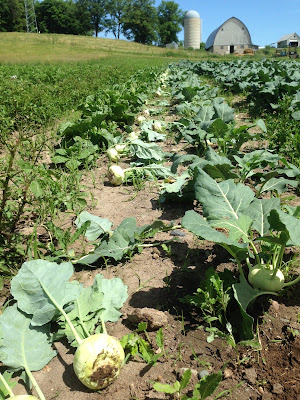First, let me say, I love the U.S., but I feel we have a problem in this country. Our culture loves big things: big cars, big yards, big businesses. I suppose it's not the bigness itself that's the issue, but this palpable sense that what's big is successful. Ladies over coffee fawning over another woman's kid whose billable hour is huge and clients are a household name drop phrases like "Wow, hasn't he made a name for himself." Neighboring farmers gawking at the 1,000,000 bushel bin put up by the ambitous guy down the road give their best Midwestern compliment, "Boy, he must be doing all right..." We judge places and organizations the same way. We're attracted to new development, more businesses of a growing community. We're dazzled with a store's bigger inventory, more products, and more and more and more.
 |
| West Otter Tail County Fair with New Barn Quilt |
This thinking is quite natural. It's part of our biology to seek out abundance, just like our hunter-gatherer ancestors sought out huge berry patches. The problem, however, is how we internalize this thinking and apply judgement to our lives. I've felt this a lot in my adult life. Our 4H club is small - we're failures. Our school's enrollment fell - we're failures. Our sunday school attendance is down - we're failures. Our business is small - we're failures. I'm not alone - negatively judging ourselves in comparison to others is a pervasive and ugly epidemic in the 21st century that brings friends to antidepressents and rural communities to despair. Dollars flow to big box stores and local stores close. Everybody wants to be part of that big exciting congregation and rural churches suffer. That big school in the regional center offers more opportunity, so let's take our kids there and our district's school falls behind.
If you know me and read this blog, I don't let these feelings affect me or second-guess the direction of my life. I put my energy into the small but beautiful things that feed my soul and our community regardless of the wider world: a tiny farm, small 4H club, and small sunday school. I also log hours on the board of
MANNA Co-op in Detroit Lakes, a tiny store starting up in the next couple of weeks in the age of big box grocery. If we step back, I think most of us realize that these images of bigness and success are often mirages - they're fake. If I'm feeling cynical, these images of success are part of a big con game that multinational corporations are playing on us to consume more of their stuff or show their dominance to scare off competition; I certainly won't let some corporate exec in NY define me. So, what to do? Let's let go of all of this envy and baggage and dig into the work and love of our daily lives. It's exciting to see where it takes us.
In the box:
Fresh Fennel: See recipe
A Couple Onions: The red one is a Tropea Torpedo Onion and the white is a sweet onion
Norland Potatoes
Swiss Chard
Greenleaf Lettuce
A Cucumber
A Couple Summer Squash
Basil
Ryan's Organic Pizza Hotdish
A pint of canned tomatoes
Fresh Fennel
Onion
Garlic
Parsley
Pepperoni
Mozzarella cheese
Olive oil
1 lb of penne pasta
1 cup of stock (chicken, beef, vegetable)
 |
| Finished hotdish |
This is my organic take on my mom's pizza hotdish, which I love. I took a bunch of pictures like those food blogs with about 30 pictures before you hit the recipe :)
 |
| Sylvia with combined sauce and penne |
Heat oven to 350 degrees and put on salted water for pasta. Make a sauce by sauteeing equal amounts of chopped fennel stalk and onion in olive oil. When fairly soft, add minced garlic for about a minute before adding tomatoes, chopped parsley, 1/4 cup of wine and about 2T on anchovy paste (if you like the flavor). Let this simmer. Take penne out of water when almost al dente (leave undercooked..it will finish off in the oven).
 |
| Applegate uncured pepperoni with Organic Valley Mozzarella for topping pasta |
Combine pasta and sauce and put into a 13 x 9 baking pan, cover with 1-2 cups of shredded Mozzarella, top with pepperoni, and put into oven until top browns a bit.
As a bonus, you can take some of fennel fronds and combine with basil and lettuce for an herbed salad. I topped mine with caesar and Hakuri salad turnips.























